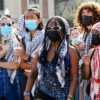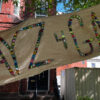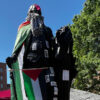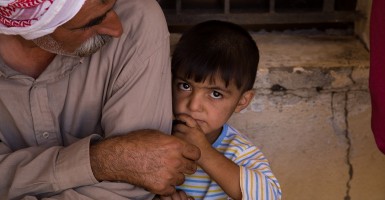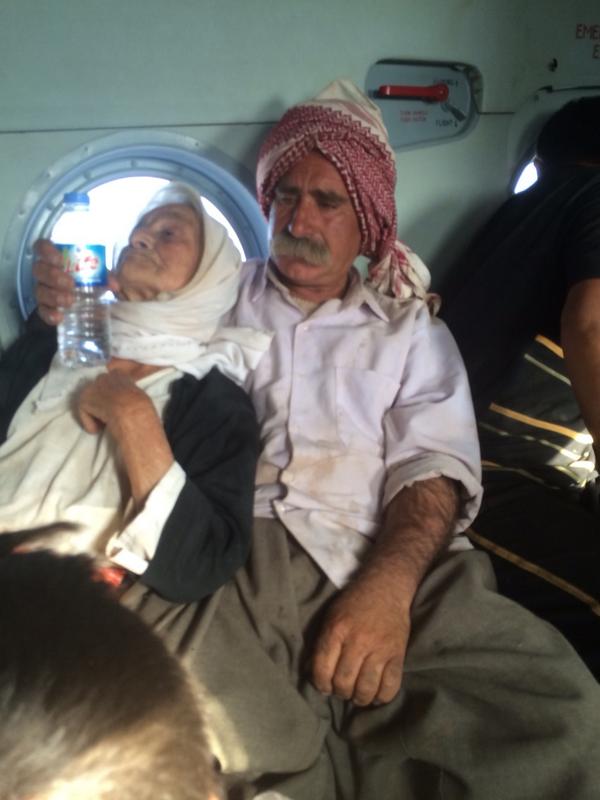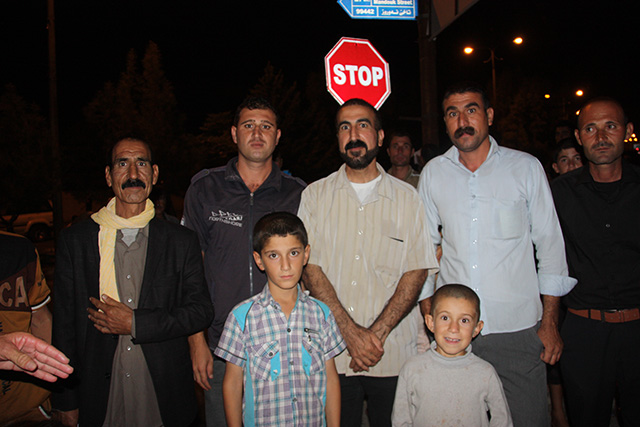Yezidis have lived in Iraq’s Sinjar region and Nineveh plains for centuries. But after recent attacks by the Islamic State, most are so scared of returning to their homes that they never want to go back.
“They love this place [Sinjar],” said Christine van den Toorn, who has lived and worked in Sulaimaniya in the Kurdistan region of Iraq for five years. “But they will never go back.”
Van den Toorn, who spoke to The Daily Signal in an interview, runs a research and analysis company with former students from the American University of Iraq and has been studying Yezidis—a religious minority group—during her time there.
She has spent time meeting with Yezidis who made it off Mount Sinjar, where tens of thousands took refuge after Islamic State militants seized their villages early last month.
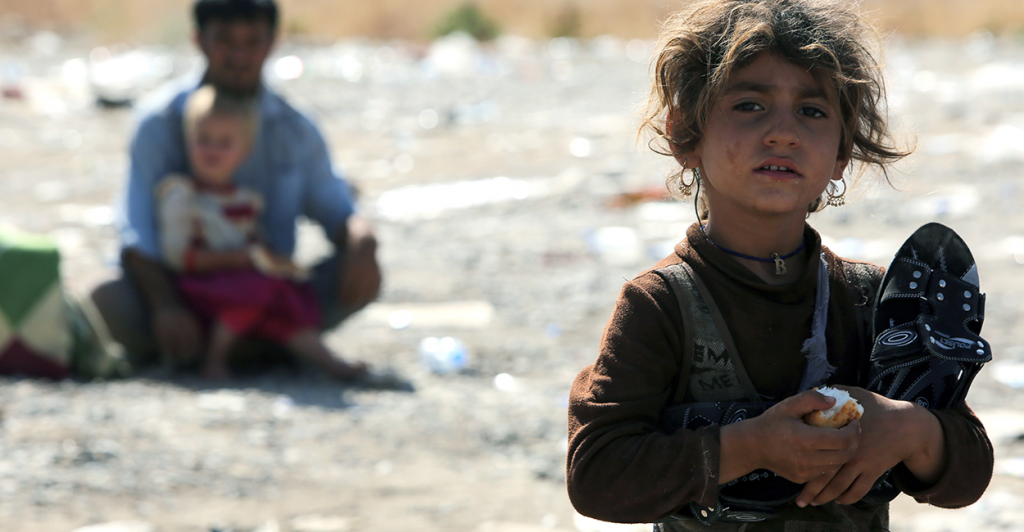
A displaced Iraqi girl from the Yezidi community holds a piece of bread Aug. 11 near the Iraqi-Syrian border. (Photo: Ahmad Al-Rubaye/AFP/Getty Images/Newscom)
Van den Toorn described a dire situation, where displaced Yezidis who made it off the mountain—or escaped Islamic State captivity—live in makeshift camps, half-finished buildings and under bridges in the Kurdish area of northern Iraq.
Smaller numbers have fled to Silopi, Turkey, and Al-Hasakah, Syria.
>>> PHOTO ESSAY: Here’s What Fear, Hunger and Faith Look Like—Yezidis on Mount Sinjar
Those who haven’t left the mountain, including thousands of armed Yezidis fighting, are staying to try to recapture control of their lives and protect their villages.
Last month, the Yezidis’ struggle became the focus of international attention and spurred President Obama into military action in Iraq.
Obama authorized airstrikes to break the terrorists’ siege of Mount Sinjar and ordered military aircraft to drop water and meals to the starving and dehydrated Yezidis.
The assistance helped Yezidi and Syrian Kurdish fighters open an escape path off the mountain.
The Iraqi military also carried out helicopter rescues for Yezidis on Mount Sinjar.
>>> Raw Footage From Iraq Yezidi Rescue: It’s the Most Bone-Chilling Video You’ll See Today
But now, the Yezidis say the world has forgotten their plight, as they live far from home with no permanency while the Islamic State continues to reign over Sinjar.
Van den Toorn says Syrian Kurds linked to the Kurdistan Workers’ Party—or P.K.K., the Turkey-based Kurdish militia that the United States considers a terrorist group—benefited from the U.S. airstrikes and were able to take back some of the towns in and around Sinjar.
After leading the rescue mission off Mount Sinjar, many of the Syrian Kurds stayed to help the Yezidis because many Yezidis are Kurdish.
Islamic State, also known as ISIS or ISIL, has targeted Yezidis because of their ancient beliefs, which the Sunni Muslim extremists consider apostate. In the last three days, Islamic State terrorists conducted an offensive and blocked off the road into Syria, preventing additional Syrian Kurdish fighters from entering Sinjar.

A Yezidi girl stays at a shelter in Iraqi Kurdistan because militants occupy her home village. (Photo: Courtesy of Mirza Ismail)
The Syrian Kurds who defend the mountain have helped train a local armed group of Yezidis, mostly younger men and women, to assist in the fighting, van den Toorn said.
Karen Zareski, a spokesperson for the U.S. State Department’s Bureau of Democracy, Human Rights, and Labor, told The Daily Signal that 2,000 to 4,000 armed Yezidis are fighting the Islamic State.
The U.S. State Department says 2,000 to 4,000 armed Yezidis remain in Sinjar fighting the Islamic State.
Zareski said another 2,000 Yezidi civilians remain on Mount Sinjar, where some lived prior to the Islamic State siege.
But most of the estimated 300,000 Yezidis who once lived in Sinjar are now internally displaced in their own country.
To understand the current situation for the Yezidis, who mostly took refuge in the cities of Zakho, Dohuk, and Erbil in Iraqi Kurdistan, The Daily Signal spoke with Mirza Ismail, the chairman of the Yezidi Human Rights Organization.
Ismail, who traveled to Kurdistan this month and met with officials from the U.S. State Department’s International Religious Freedom Office, said the local groups are fighting for themselves in a way the Iraqis and the Kurdistan Regional Government would not.

Mirza Ismail, chairman of the Yezidi Human Rights Organization, sits outside the White House awaiting a meeting with Obama administration national security officials. (Photo: Kelsey Harkness/The Daily Signal)
Taking Up Arms
The Yezidi men pictured below want to return to their villages to fight the Islamic State.
“They want to liberate our villages,” Ismail said. “The KRG and Iraqi government failed to support us, so why not support ourselves?”
Ismail and van den Toorn say the Yezidi fighters defending Mount Sinjar—and the Syrian Kurds helping them—are poorly armed, and any potential U.S. aid to the Syrian Kurds is complicated by their connection to the PKK.
Help or not, Yezidis are taking up arms in many forms.
They’ve allied with Iraqi Christians, another minority group, for mutual protection.
Last month, Iraq’s most prominent Christian political party, the Assyrian Democratic Movement, issued a call for volunteers from minority groups—including Yezidis—to form a local defense force to fight the Islamic State.
Kaldo Oghanna, the foreign relations coordinator for ADM, told The Daily Signal in an email that about 2,000 volunteers have signed on for the mission.
Hundreds already are protecting villages and houses in and around Alqosh, an Assyrian Christian town in northern Iraq.
Oghanna said the group has asked the Iraqi and Kurdish governments to coordinate with the volunteers to establish a base of operations and has lobbied the international community for arms and training.
“The necessity is to empower the minorities for them to protect their areas,” Oghanna said. “Our people are able and ready to defend their people and lands and secure it.”
>>>‘No Future for Yezidis in Iraq’: Man Waits for Word of Loved Ones’ Safety
Yezidis do not trust the local peshmerga–which generally is considered effective and receives arms from the U.S.–to keep them safe. They say fighters from the peshmerga of the Kurdistan Regional Government in Iraq who were providing security for Sinjar, abandoned their posts when Islamic State forces arrived.
“We’d rather have chemical bombs dropped on us than trust the KRG,” Ismail said. “You are guarding my door, and then you leave it open for thieves to kill us. What are they there for?”
“We’d rather have chemical bombs dropped on us than trust the KRG,” said Mirza Ismail, speaking about the Kurdish peshmerga.
Jim Phillips, an expert on the Middle East at The Heritage Foundation, said it may not have been the peshmerga’s fault.
“The withdrawal reportedly was a military necessity to avoid being surrounded, but many Yezidis harbor suspicions about Kurdish motives,” Phillips said. “Although many Yezidis belong to the Kurdish ethnic group, there are religious tensions with the Kurds, who primarily are Sunni Muslims. Yezidis are an insular group with bitter memories of persecution by Kurds, Arabs and Ottoman Turks.”
Van den Toorn is more skeptical.
“Every single Yezidi, 100 percent, believes the KRG [peshmerga] hung the Yezidis out as bait to get heavy weapons support from the U.S.,” van den Toorn said. “There is no doubt they feel no force protected them.”
Captive Life
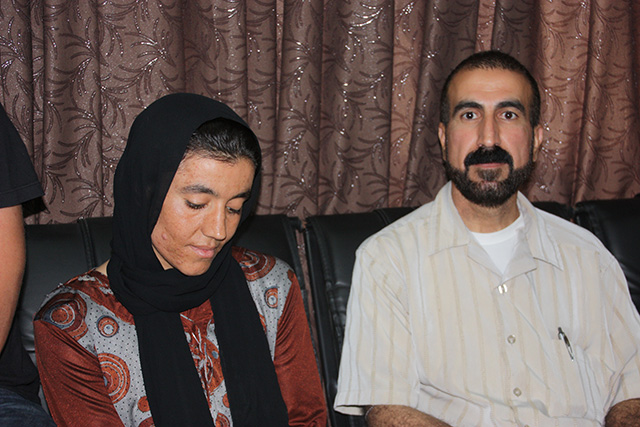
Mirza Ismail (right) met Zaton, a Yezidi woman who was kidnapped by ISIS. (Photo: Courtesy of Mirza Ismail)
The United Nations estimates 1.8 million people in Iraq have been displaced by violence since January, including tens of thousands of Yezidis.
Van den Toorn estimates 1,000 are prisoners of the Islamic State, most of them women, girls and boys who are younger than 12–the cutoff age for Islamic State execution.
In Dohuk, Ismail met a woman who survived Islamic State captivity.
The woman, named Zaton, was kidnapped by the Islamic State on Aug. 3, when the militants took over Sinjar.
Zaton, her face scarred because her Islamic State captors forced her to wash it with gasoline, eventually escaped alone.
She lost 12 family members, including her father, to Islamic State killers.
Her own fate consisted of being sold a few times from one Islamic State militia to another and regular beatings delivered with cables.
She managed to escape in the middle of the night through an open door and walked for three days before she found a cousin near Mount Sinjar.
She eventually managed to get a ride to Dohuk, a roughly four-hour drive from Sinjar.
Temporary Living
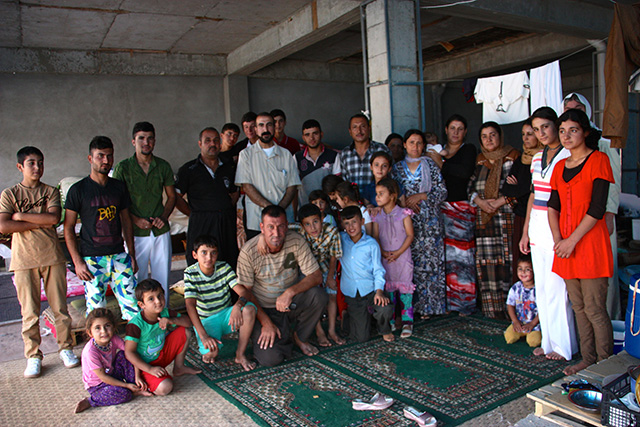
Many Yezidis take refuge in unoccupied buildings, where they live on one meal a day. (Photo: Courtesy of Mirza Ismail)
In an abandoned, windowless building in Dohuk, nine families or so subsist on one meal a day. Children play on small rugs to shield them from the hot cement ground.
There are informal living quarters such as those speckled throughout the cities of Zakho, Dohuk, and Erbil in Iraqi Kurdistan: a patch of grass here, a shaded bridge there.
Most are registered by the United Nations, van den Toorn says.
More formal camps are being built, but it’s difficult to keep up with demand. According to the State Department, the U.S. has provided $186 million in food, water, shelter materials, relief supplies and programs to help the most vulnerable populations.
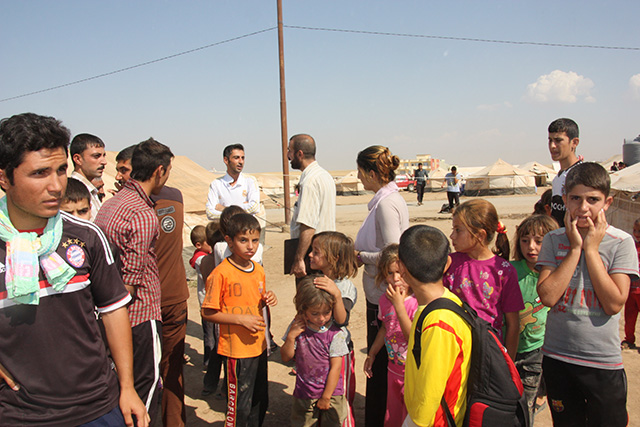
At a makeshift shelter in Khanki, some 67,000 Yezidi refugees arrived in a matter of days. (Photo: Courtesy of Mirza Ismail)
At a makeshift shelter in Khanki, a tiny town east of the Mosul Dam, 67,000 Yezidi refugees arrived in a matter of days.
The Barzani Charity Foundation, a Kurdish non-governmental organization, has set up a food kitchen. The U.N. World Food Programme also serves the refugees.
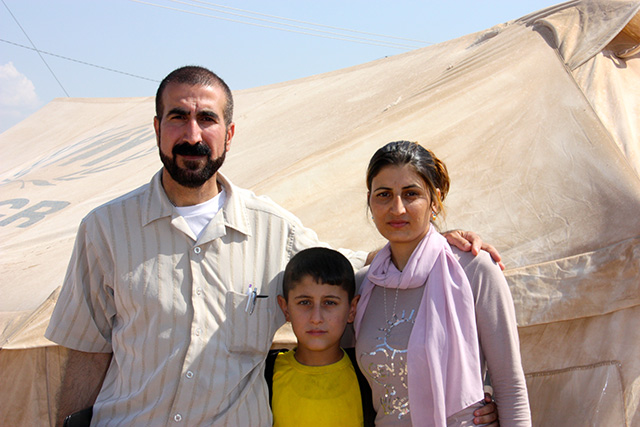
At this shelter, Ismail reunited with one of his sisters, Mayson, 23, and her son, Milad, 10. (Photo: Courtesy of Mirza Ismail)
At this shelter, Ismail by chance reunited with one of his sisters, Mayson, 23, and her son, Milad, 10.
Mayson is one of six of Ismail’s sisters who were stuck on Mount Sinjar, along with his wife, parents and four brothers. All escaped, but two of his teenage cousins are captives of Islamic State militants.
For Ismail, the moment with Mayson was especially emotional.
Ismail, who fled Sinar in 1991 and now lives in Canada, quit his job as a social services worker to help Yezidis—and here he was, assisting his sister.
Uncertain Future

Schools serve as shelters and bring warmth from the coming harsh winter. (Photo: Courtesy of Mirza Ismail)
Schools such as this one in Dohuk represent one of the most secure shelters for Yezidis. They have roofs and thus offer reprieve from Iraq’s harsh winters.
Zareski says the United States is already looking ahead to winter, providing items such as blankets and warm clothing for refugees.
But such an act is temporary.
Many believe the Islamic State’s routing of Yezidis should be the catalyst for meaningful change.
“There needs to be a more long-term, permanent solution for Yezidi families from Sinjar,” van den Toorn said. “Because we’re talking about a religious minority group and because, literally, they never want to return home.”
One potential solution won’t be an option any longer.
Because many Yezidis from Sinjar worked for the U.S. military as translators, Congress has provided some with asylum in the United States.
>>> As ISIS Tells Yezidis to ‘Convert to Islam or Die,’ One Man Pleads for Help at White House
The Special Immigrant Visa, created under the 2008 Defense of Authorization Act, allotted 25,000 visas for translators who served the U.S. Army from 2005 to 2010.
The program, which Congress extended in December, before the Islamic State came to power, expires today.
A State Department official told The Daily Signal that those who have already applied for the program will continue being considered for the program after today. New applications, however, will not be accepted.
The State Department official says the National Defense Authorization Act allotted the issuance of 2,500 visas for fiscal year 2014. More than 1,400 of those have already been awarded.
“[This] may be sufficient to meet expressed demand for the program at this time,” the official said.
The program won’t end until all 2,500 visas are issued. Some 2,700 applicants are at some stage of the approval process.
“The majority of these cases are pending action by the applicant, such as submission of required forms or other information,” the official said.
Van den Toorn contends that a cumbersome application process makes required documents, such as “employment verification” or an “HR” letter, hard to come by.
“I’ve seen a lot of emails between Yezidis and the State Department, and it’s clear that it’s difficult for the Yezidis to understand the requirements,” said van den Toorn, who has taken on 10 cases herself to help Yezidis navigate the system.
Van den Toorn says the State Department recently has become more flexible with the documents it accepts to confirm an applicant actually worked for the U.S. Army.
Even if the program benefits some, most Yezidis don’t qualify.
Still, van den Toorn and Ismail say the United States and other western countries should act generously in providing Yezidis asylum.
“Yezidis have been friends with Muslims before,” van den Toorn said. “But looking back at history, they feel it’s only a matter of time before this happens again. They don’t feel comfortable living in a majority Muslim area anymore. That’s it.”
But not everyone will want to leave.
There will always be Yezidis who refuse to live anywhere else but Sinjar, amongst its holy temples and slow farming life.
For those people, Ismail has been lobbying for protection.
He wants the Iraqi government to provide a separate territory for the Yezidis and Christians in the Sinjar region and Nineveh plains.
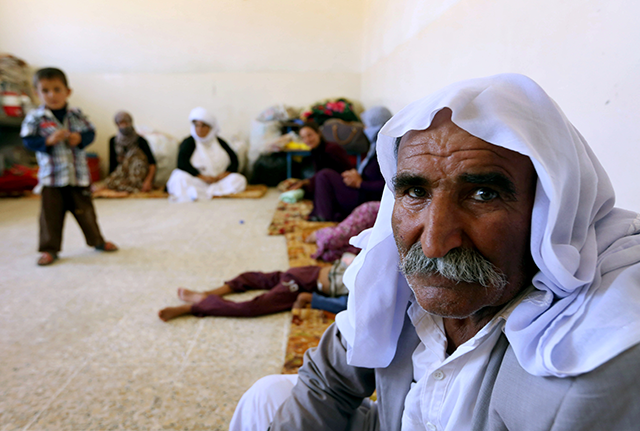
A file picture taken on Aug. 5 shows an Iraqi Yazidi family that fled the violence in the northern Iraqi town of Sinjar, sitting at at a school where they are taking shelter in the Kurdish city of Dohuk in Iraq’s autonomous Kurdistan region. (Photo: Newscom)
Van den Toorn and Ismail also argue that the international community should provided armed support to the local Yezidi force to protect the region. She says NATO should provide troops to serve as peacekeepers for Sinjar.
“All they [Yezidis] talk about is Sinjar, and their figs and farms and houses,” van den Toorn said. “They love that place.”


